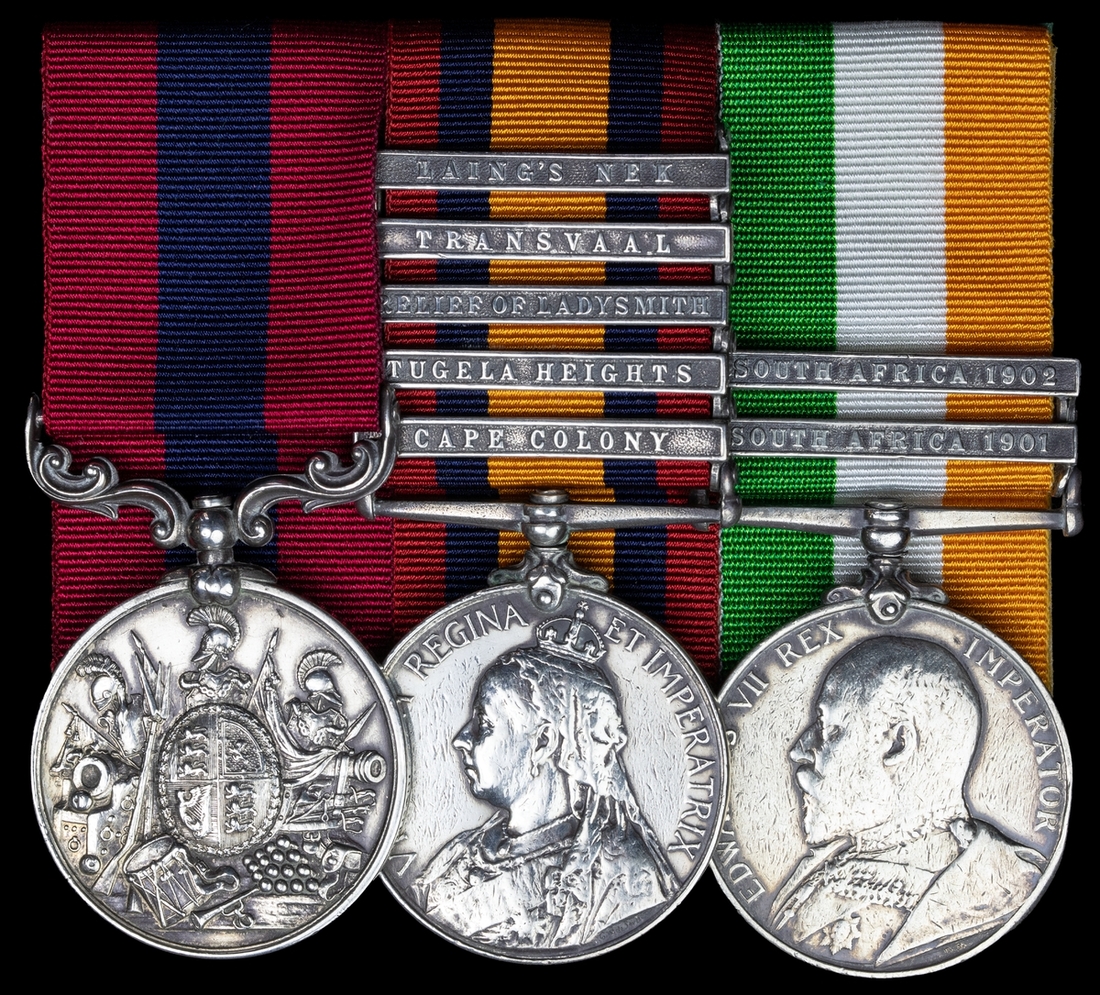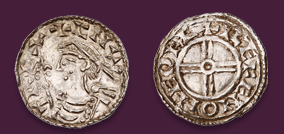
Auction: 25003 - Orders, Decorations and Medals
Lot: 199
The 'Vaal Krantz 1901' D.C.M. group of three awarded to Sergeant J. H. Brooke, Rifle Brigade
Distinguished Conduct Medal, V.R. (2052 Sjt J. H. Brooke, 1st Rifle Brigade); Queen's South Africa 1899-1902, 5 Cape Colony, Tugela Heights, Relief of Ladysmith, Transvaal, Laing's Nek (2052 Serjt. J. Brooke. Rifle Bde.); Kings South Africa 1901-02, 2 clasps, South Africa 1901, South Africa 1902 (2052 Serjt: J. H. Brooke. Rifle Brigade.) light contact marks (3)
D.C.M. London Gazette 19 April 1901, the citation given in London Gazette 8 February 1901:
'Conspicuous coolness under fire and dressing 2 men's wounds at Vaal Krantz under heavy fire.'
M.I.D. London Gazette 22 February 1901.
James Henry Brooke was born at Longford Ireland on 14 June 1870, the son of James and Jane Brooke. His father was a Clerk of Ordnance Stores from London and the family moved back there only ten years after the younger Brooke's birth. He joined the Rifle Brigade prior to the outbreak of the Anglo-Boer War and was serving with the rank of Sergeant when he entered that war in South Africa.
The 1st Battalion, Rifle Brigade arrived on the Cape in November 1899 as part of General Lyttleton's 4th Brigade. They joined General Buller's Army advancing towards the Boer forces on the Tugela River, seeing limited action at Colenso and missing out on Spion Kop entirely they were to be thoroughly blooded at Vaal Kranz.
The Battle of Vaal Kranz was the third attempt to Cross the Tugela River by General Buller in the wake of the failed assault on Spion Kop. While Kitchener made a show of preparing to cross at Potgeiter's Drift Lyttleton's Brigade crossed at Munger's Drift opposite the heights of Vaal Krantz. Unfortunately, the slow pace of the British advance allowed the Boer's time to prepare their defences and the British advanced into a heavy fire. Fortunately for them that stretch of the line was ill defended and they took the summit after a tough advance, a letter to the Editor in the Rifle Brigade Chronicle dated 1 November 1900 gives further details stating:
'About 2 p.m. the 68th crossed the pontoon bridge, supported by our Battalion, and we advanced across an open plain, fired at from three sides by every sort of gun and rifle for about a mile and a half, when we reached and occupied a hill. Our companies on the right under Lamb had a hot time. Thorpe, Blewitt, and Cuninghame were wounded, and many N.C.O.'s and men were hit.
The Battalion occupied the right end of a ridge, and the centre and left were held by the 68th. We spent most of the night building walls, and at 5.30 a.m. next day the Boers opened fire on us, and kept it up all day. We were fortunate in having very few casualties in the firing line, but we had a good many among the supports. Talbot was hit in the shoulder, and an infuriated little man was seen bounding out of an ant-bear hole, who proved on inquiry to be Ellis, shot in the foot. Sergeant-Major Morrish brought our rations along the river bank on the ammunition mules; two of his mules were killed, and he speaks very strongly on the subject of using white mules on service.
About 7 p.m. we were relieved by Hildyard's Brigade, but it was a very difficult and long operation, and we did not get back under Zwartz Kop till nearly midnight. This is a rather bald and incomplete account of the best thing we were in.'
The Battalion saw 5 killed and 81 wounded including five officers, it was for his bravery in dressing the wounds of two of these men under fire that Brooke received his laurels. He was additionally 'mentioned' in Buller's dispatch for the Battle written on 8 February 1900 but not published until 22 February 1901.
They saw extremely heavy fighting in the eventual breaking of the Boer defensive line between 14-27 February. Serving one of the leading Battalions in their Brigade at the time their losses for the period came to 14 dead and 125 wounded. Present for the Relief of Ladysmith they saw operations at Laing's Nek where the Boer defences were breached while the 4th Brigade paraded to distract the enemy.
After the guerrilla phase of the war ended Brooke continued to service, reaching the rank of Colour Sergeant and earning his L.S. & G.C. in 1908. Leaving the military before the Great War he appeared upon the 1911 census working as a nightwatchman and living in Willesden. He must have lived to a ripe old age as he as recorded on the 1939 census living in Essex however his date of death is not known; sold together with copied research.
Further entitled to an Army. L.S. & G.C., A.O. 254 in October 1908.
Subject to 20% VAT on Buyer’s Premium. For more information please view Terms and Conditions for Buyers.
Estimate
£1,600 to £2,000
Starting price
£1200




